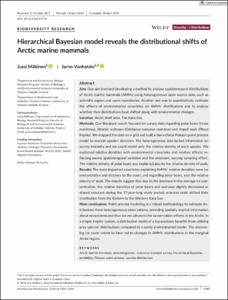| dc.contributor.author | Makinen, Jussi | |
| dc.contributor.author | Vanhatalo, Jarno | |
| dc.coverage.spatial | Kara Sea | en_US |
| dc.date.accessioned | 2023-04-20T05:41:57Z | |
| dc.date.available | 2023-04-20T05:41:57Z | |
| dc.date.issued | 2018 | |
| dc.identifier.citation | Mäkinen, J. and Vanhatalo, J. (2018) Hierarchical Bayesian model reveals the distributional shifts of Arctic marine mammals. Diversity and Distributions, 24:12776, pp.1381–1394. DOI: https://doi.org/10.1111/ddi.12776 | en_US |
| dc.identifier.uri | https://repository.oceanbestpractices.org/handle/11329/2185 | |
| dc.description.abstract | Our aim involved developing a method to analyse spatiotemporal distributions of Arctic marine mammals (AMMs) using heterogeneous open source data, such as scientific papers and open repositories. Another aim was to quantitatively estimate the effects of environmental covariates on AMMs' distributions and to analyse whether their distributions have shifted along with environmental changes. Location: Arctic shelf area. The Kara Sea. Methods: Our literature search focused on survey data regarding polar bears (Ursus maritimus), Atlantic walruses (Odobenus rosmarus rosmarus) and ringed seals (Phoca hispida). We mapped the data on a grid and built a hierarchical Poisson point process model to analyse species' densities. The heterogeneous data lacked information on survey intensity and we could model only the relative density of each species. We explained relative densities with environmental covariates and random effects reflecting excess spatiotemporal variation and the unknown, varying sampling effort. The relative density of polar bears was explained also by the relative density of seals. Results: The most important covariates explaining AMMs' relative densities were ice concentration and distance to the coast, and regarding polar bears, also the relative density of seals. The results suggest that due to the decrease in the average ice concentration, the relative densities of polar bears and walruses slightly decreased or stayed constant during the 17-year-long study period, whereas seals shifted their distribution from the Eastern to the Western Kara Sea. Main conclusions: Point process modelling is a robust methodology to estimate distributions from heterogeneous observations, providing spatially explicit information about ecosystems and thus serves advances for conservation efforts in the Arctic. In a simple trophic system, a distribution model of a top predator benefits from utilizing prey species' distributions compared to a solely environmental model. The decreasing ice cover seems to have led to changes in AMMs' distributions in the marginal Arctic region. | en_US |
| dc.language.iso | en | en_US |
| dc.rights | Attribution 4.0 International | * |
| dc.rights.uri | http://creativecommons.org/licenses/by/4.0/ | * |
| dc.subject.other | Arctic marine mammals | en_US |
| dc.subject.other | Extensive transect survey | en_US |
| dc.subject.other | Hierarchical Bayesian modelling | en_US |
| dc.subject.other | Species distribution | en_US |
| dc.title | Hierarchical Bayesian model reveals the distributional shifts of Arctic marine mammals. | en_US |
| dc.type | Journal Contribution | en_US |
| dc.description.refereed | Refereed | en_US |
| dc.format.pagerange | pp.1381-1394 | en_US |
| dc.identifier.doi | http://dx.doi.org/10.1111/ddi.12776 | |
| dc.subject.parameterDiscipline | Human activity | en_US |
| dc.subject.dmProcesses | Data aggregation | en_US |
| dc.subject.dmProcesses | Data acquisition | en_US |
| dc.bibliographicCitation.title | Diversity And Distributions | en_US |
| dc.bibliographicCitation.volume | 24 | en_US |
| dc.bibliographicCitation.issue | Article 12776 | en_US |
| dc.description.sdg | 14.2 | en_US |
| dc.description.methodologyType | Reports with methodological relevance | en_US |
| obps.contact.contactname | Jussi Makinen | |
| obps.contact.contactemail | jussi.makinen@helsinki.fi | |
| obps.resourceurl.publisher | https://onlinelibrary.wiley.com/doi/10.1111/ddi.12776 | |
 Repository of community practices in Ocean Research, Applications and Data/Information Management
Repository of community practices in Ocean Research, Applications and Data/Information Management

